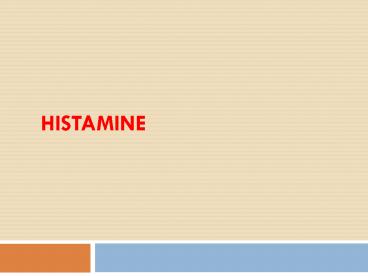HISTAMINE PowerPoint PPT Presentation
1 / 37
Title: HISTAMINE
1
HISTAMINE
2
Storage Sites
3
RELEASE
4
Storage and release
- Histamine is usually found in storage granules as
complex with sulfated polysacharides, heparin and
released (locally) by - a) immunologicl Mechanism (During Allergic
Reaction (see Fig 56-5) - b) Tissue injury Mast cell
degranulation - c) Chemical and physical Conditions( see table
51-2)
5
(No Transcript)
6
Chemical and Physical Agents that Release
Histamine
Physical Agents Chemical Agents
Mechanical trauma, Radiant energy, Thermal energy Chymotrypsin, Compound 48/80, Detergents, Dextran, DMSO (dimethyl- sulfoxide), Morphine and other Opiods, Pentamidine , Polymyxin B, Polyvinyl pyrrolidine, Propamidine, eserpine, Surface active agents, Stilbamidine, Toxins, Tubocurarine, venoms, X-ray contrast media
7
Rlease
- Primary mechanism during allergic reactions IgE
antibody interacts with antigen on the surface of
mast cells - Enzymes as trypsin or drugs as morphine liberate
histamine without prior sensitization - Inhibition of release with ß2 agonists
8
SYNTHESIS INACTIVATIONTION
9
H istamine
CNS
ANS
H 1
H 2
H 3
H 3
-ve presynaptic autoregulation
10
Histamine receptors
ReceptorType Major Tissue Locations Major Biologic Effects
H1 smooth muscle, endothelial cells acute allergic responses
H2 gastric parietal cells secretion of gastric acid
H3 central nervous system modulating neurotransmission
H4 mast cells, eosinophils, T cells regulating immune responses
11
Histamine receptors antagonistsWhat is the
physiological Antagonist of Histamine?
12
First generation Diphenhydramin, Promethazine
etc (Sedating and Pass Blood Brain Barriers)
H1 antagonists
- Clinical uses
- Antinausia and Vomiting
- Insomnia
- Cough
- Motion sickness
- Allergy
13
Second generation. Loratadine
H1 antagonists
- Non-sedating
- Clinical uses
- Allergic conditions
- Allergic rhinitis
- Conjunctivitis
- Urticaria
14
Ranitidine
H2 antagonists
- Inhibitor of gastric acid secretion
- Used in the treatment of
- peptic ulcers
15
BETAHISTINE
H3 antagonists
- Used in treatment of
- vertigo in middle ear
16
Eicosanoids (Prostaglandins)
17
(No Transcript)
18
INHIBITORS OF EICOSANOIDS
19
Drugs
Corticosteroids
Zileuton
NSAIDs
20
ACTIONS
21
Vascular smooth muscles
- PGE2 and PGI2
- Thromboxane A2
- Potent vasoconstrictor.
Potent vasodilators .
22
Blood
TXA2 a potent inducer of platelet aggregation.
- PGE2 and PGI2
- inhibit platelet aggregation
23
Inflammation
- One of the chemical mediators in inflammatory
reactions.
24
Bronchial smooth muscle
-PGE2 cause dilatation.
- -PGF2?
- -LTs and thromboxane are potent
bronchoconstrictors in man ? allergic
bronchospasm.
25
Uterine smooth muscle
PGE2 and PGF2? ? Menstruation/ Dysmenorrhea/
Labor contractions
26
GIT smooth muscle
- - PGE2 and PGF2? and LTs
- GIT
- motility
27
GIT secretions
- PGE2 , PGE1 PGI2
- ?acid and pepsinogen secretion .
- ? mucin, water and bicarbonate Blood flow.
28
Kideny
- PGE2 and PGI2 increase renal blood flow and
diuresis.
29
Central and peripheral nervous systems
- Fever PGE1 and PGE2 increase body temperature.
30
CLINICAL USES OF PGs ANALOGS
31
Carboprost
- PGF2a ( analog)
- Abortifacient
- Trigger abortion in first trimester.
32
2) For postpartum haemorrhage
vasoconstriction uterine muscle contraction
33
Latanoprost
- (PGF2a analog )
- eye drops in open angle glaucoma.
- ? IOP by enhancing outflow of the aqueous humar.
34
Alprostadil
- (PGE1analog)
- 1- Injected in corpus cavernosum of the
penis for some forms of male
impotence.
35
- 2- In congenital heart anomalies
- to keep the patent ductus arteriosus until
surgery.
36
Misoprostol
- (PGE1 analog)
- Peptic ulcer
37
Thank you

